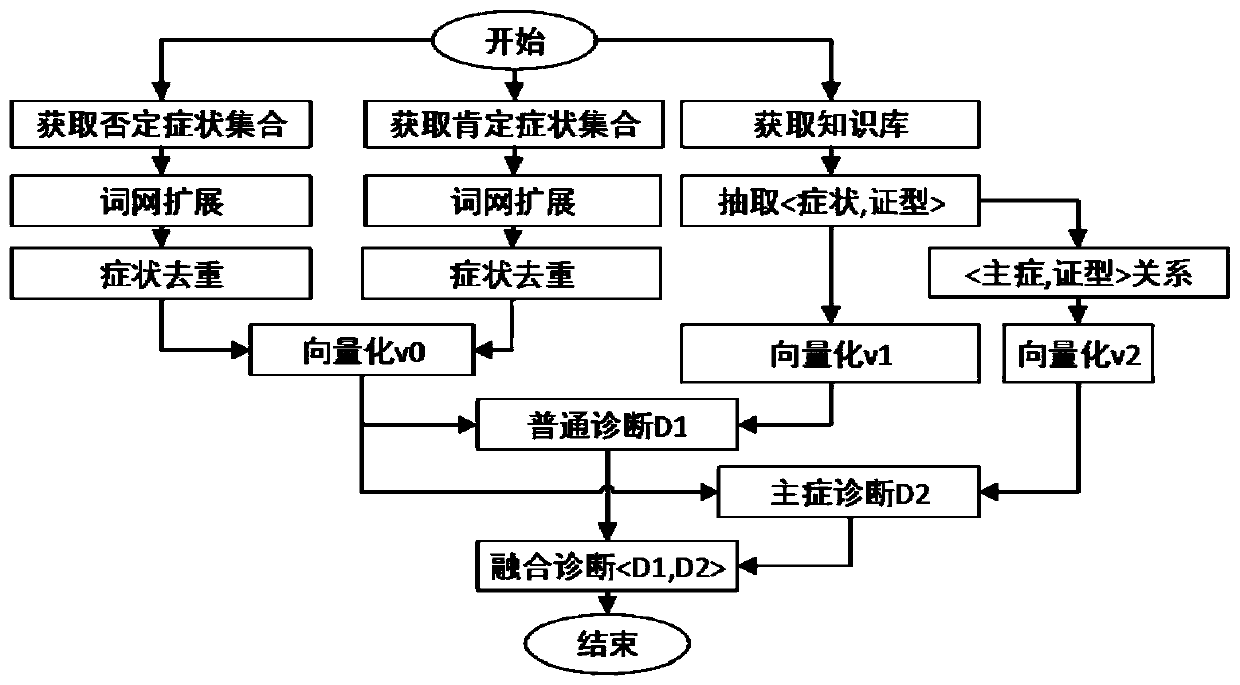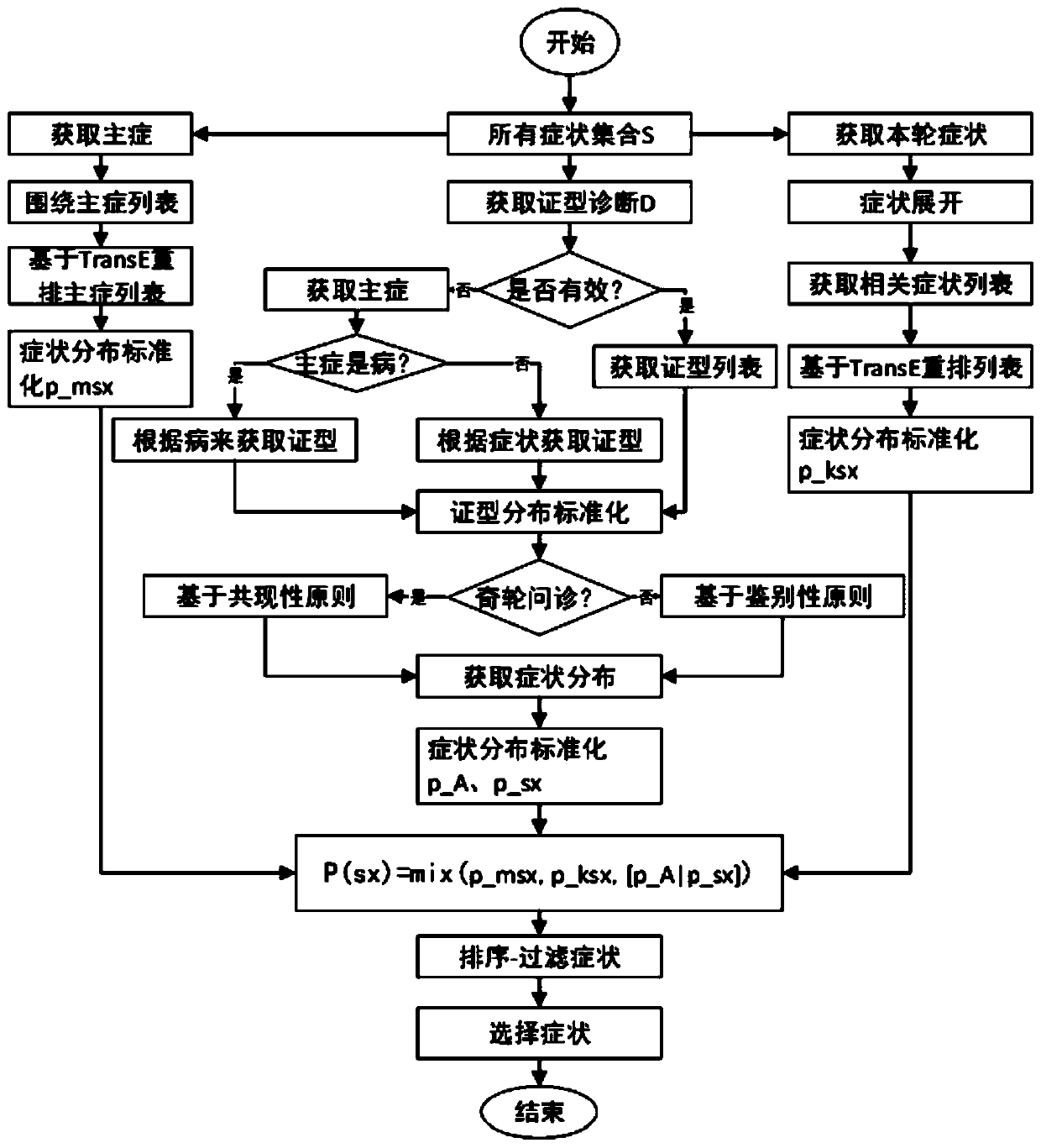Robot active inquiry method based on traditional Chinese medicine clinical knowledge graph
A technology of knowledge map and robot, which is applied in the field of robot active consultation based on clinical knowledge map of traditional Chinese medicine, which can solve the problems of complexity and difficulty of artificial intelligence consultation
- Summary
- Abstract
- Description
- Claims
- Application Information
AI Technical Summary
Problems solved by technology
Method used
Image
Examples
Embodiment 1
[0134] This embodiment provides a process of establishing a TCM clinical knowledge graph.
[0135] The establishment of a TCM clinical knowledge map mainly includes the steps of knowledge modeling, setting knowledge sources, knowledge extraction, and knowledge fusion;
[0136] 1.1. Knowledge modeling: disease, disease location, nicknames, syndromes, symptoms, treatment rules, prescriptions, and Chinese medicinal materials are entities, and the entities are related to each other; every two entities are connected by a line to form a ternary Group, ie ; for example, represe , The first such as wrapped>;
[0137] 1.2. Set knowledge sources; in this embodiment, the knowledge sources include TCM clinical terminology system, TCM internal medicine knowledge base, TCM expert summary processing, online TCM-related Q&A and consultation on the Internet, encyclopedia knowledge on the Internet, Ancient medical records, medical records, etc.;
[0138] 1.3. Knowledge extraction: Knowledge extractio...
Embodiment 2
[0160] This embodiment provides a predictive reasoning model M based on the TCM clinical knowledge graph obtained by using the method described in embodiment 1. transH The specific steps are:
[0161] 2.1. The TCM clinical knowledge map KG obtained from the method in Example 1 tcm Three files are output in the file, the first file is the entity code file, which represents the digital code of the entity; the second file is the relation code file, which represents the digital code of the entity; the third file is the knowledge triple data after the encoding;
[0162] 2.2. According to the knowledge triple data, use a random strategy to generate negative sample data Δ', and positive sample data is expressed as Δ;
[0163] 2.3. Introduce TransH to train the TCM clinical knowledge map; suppose a fact (h, r, t), r represents the relationship vector, d r Through r through vector w r ∈R is obtained by projection, h and t represent entity vectors, and the score that defines the r relationship...
Embodiment 3
[0175] This embodiment provides a TCM syndrome identification process based on the TCM clinical knowledge graph. The robot's consultation process is essentially collecting patient information about symptoms. Suppose that the current robot collects the patient's symptom information set S, and the robot compares the set S with the knowledge of the TCM clinical knowledge map to diagnose the syndrome type and disease of the disease. The expected diagnosis result is the syndrome type distribution, such as figure 2 As shown, the specific steps are:
[0176] 3.1. From the TCM clinical knowledge map KG tcm Acquire knowledge points of Chinese medicine and convert them into sx , Card type KR s >The record form, denoted as KR ssx ;
[0177] 3.2, from KR ssx Extract msx , Card type KR s >The record is marked as KR mssx ;
[0178] 3.3, put KR sx , KR msx The two sets are vectorized separately:
[0179] 3.3.1. Find out KG of TCM clinical knowledge graph tcm Symptom Collection S tcm , Remembe...
PUM
 Login to View More
Login to View More Abstract
Description
Claims
Application Information
 Login to View More
Login to View More - R&D
- Intellectual Property
- Life Sciences
- Materials
- Tech Scout
- Unparalleled Data Quality
- Higher Quality Content
- 60% Fewer Hallucinations
Browse by: Latest US Patents, China's latest patents, Technical Efficacy Thesaurus, Application Domain, Technology Topic, Popular Technical Reports.
© 2025 PatSnap. All rights reserved.Legal|Privacy policy|Modern Slavery Act Transparency Statement|Sitemap|About US| Contact US: help@patsnap.com



